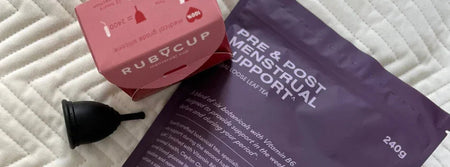Being up close and personal with your monthly flow can take some getting used to if you are a menstrual cup newbie. At Ruby Cup, we get lots of questions from our cup aficionados about their period blood. We love helping people with periods better understand their bodies and their cycles, so we’re thrilled to answer all of your menstrual flow questions. So keep reading if you're curious (and you know you are) to figure out why your menstrual blood is slimy.
This article is written by clinician Amy Harris. Read more about Amy Harris at the end of the article.
Is menstrual blood the same as regular blood?
No. Menstrual blood is much more than just blood. Normal blood consists of plasma, white blood cells (infection-fighters), red blood cells (oxygen-transporters), platelets (clot–formers), and water. Your menstrual flow is blood (with the ingredients from above) mixed with secretions from the vagina and cervix and old tissue (lining of your uterus).
The lining of your uterus is called the endometrium. The hormone estrogen stimulates your lining to grow and thicken throughout your monthly cycle. This fluffy, cozy endometrium’s purpose is to provide the perfect, nourishing home for a fertilized egg to implant, if you get pregnant. If it is not your month to become a parent (the egg is not fertilized), a drop in another hormone (progesterone) signals the lining to start sloughing off. This tissue can give period flow a slimy consistency that is totally normal.
Menstrual blood is generally thicker than water and ordinary blood. The consistency of your menstrual blood is dependent on whether you use any hormone-containing birth control (see FAQs below), how hydrated you are, and to a smaller extent, the diet you follow. We unpacked how some of these factors change the length of your cycle in our post about how to make your period end faster.

Why is menstrual blood slimy?
Menstrual blood may seem and feel slimier than the blood dripping from a scrape on your knee. That is because those secretions from the vagina and cervix mentioned above contain mucin. Mucin is the main ingredient in the slimy snot that clogs your nose and throat when you get a cold. It also makes your menstrual blood seem slimy some days of your cycle. You have mucin-secreting cells lining your throat, nose, uterus, and the canal through your cervix.
The relative amounts of menstrual blood ingredients change each day of your period. That is why the first few days of your period, your flow is usually more of a liquid blood stage, followed by a thicker paste-like stage, and finishing with a clear liquid like your normal vaginal secretions.
Why does menstrual blood sometimes have slimy clumps in it?
All blood, even menstrual blood, is designed to form clots when it is not freely flowing. Clots are your body’s way of preventing you from losing too much blood. Blood clots in other parts of the body can be harmful (like in your lungs or brain), but they are normal and healthy when it comes to menstrual flow.
The blood clots in your menstrual flow can seem especially slimy and almost jello-like because they combine coagulated blood (blood that is semi-solid, partially clotted), tissue, and blood that has not yet clotted. It is normal for people with periods to have more clots during the first couple of days of their cycle.
Menstrual blood clots can have different sizes – in general, it is normal to have a few strawberry-sized clots. Your menstrual bleeding may be too heavy if you have to change your tampon, menstrual pad, or menstrual cup every two hours or less for several hours in a row. If you have heavy bleeding, bleeding heavily for several hours at a time, or pass multiple plum-sized clots, it would be a good idea to check in with your healthcare provider to make sure that this amount of flow is healthy for you.
Read also: How Much Do You Bleed on Your Period? What Research Says
Do menstrual cups cause more clots in my menstrual blood?
No, menstrual cups, like Ruby Cup, do not cause you to have more clots. Instead, more clots can form in your cup before you empty it than might with a tampon or menstrual pad. Ruby Cup’s small menstrual cup holds 1-2 tampons of menstrual blood and the size medium holds 3-4 tampons of normal period flow. So, as your menstrual blood pools in your cup (for up to 12 hours), it naturally forms clots. You may see these clots when you empty and change your cup.
Because tampons and menstrual pads are super absorbent, your menstrual blood does not have time to form clots as it does with your menstrual cup. So your menstrual cup does not change your menstrual flow in terms of the amount of flow or composition of your period blood – you just see more of your flow (and clots).

How does period underwear work with blood clots?
Period underwear works with blood clots in much the same way it handles regular period flow. The absorbent layers soak up the liquid from the clot and help prevent leaks, keeping you dry and comfortable. If you tend to have larger blood clots, they might not be fully absorbed, and some clot tissue may stay on the surface. In this case, you can simply wipe it off when you go to the toilet or rinse the underwear before washing.
Since clots usually indicate a heavier flow, it's best to choose period underwear with heavy absorbency, like our high-waisted Flow freedom period panties. They have been thoughtfully designed for ultimate comfort and dependability—able to hold up to three tampons’ worth of flow. This means they’re perfectly suited for heavy days or when you need to wear them for long hours without a worry. The soft, breathable fabric and sustainable design not only provide discreet, leak-proof protection, but they also let you move confidently, embracing your natural rhythm with ease. Find out more about period pants here.
While menstrual blood’s natural sliminess is simply part of its role in supporting your body’s healthy cleansing process, having period products that works in harmony with your flow makes a huge difference.
Period products face-off: which one works best for blood clots?
| Product |
Capacity |
Clot Handling | Comfort | Best For |
|---|---|---|---|---|
| Tampons | ★★★☆☆ | May struggle with larger clots | Can feel dry or irritating | Active days, light to medium flow |
| Pads | ★★★☆☆ | Absorbs clots | Bulky and messy | Overnight use, emergency backup |
| Ruby Cup menstrual cup |
★★★★★ | Catches all clots internally | Very comfortable - you'll forget it's even there | Confident, leak-free days, sustainable choice |
| Period Underwear | ★★★★★ | Absorbs small clots & fluid together | Feels like regular underwear | Heavy flow, comfort-first days, backup with cup |
Is menstrual blood dirty or harmful?
No. There’s a common misconception in some cultures that period blood is dirty or impure. Menstrual blood contains sloughed-off tissue, perfectly normal bacteria from your vagina, and discharge from your cervix and vagina. However, none of these substances cause any problem unless they are trapped inside your body in a tampon or menstrual cup for too long, as can happen with toxic shock syndrome (TSS).
Toxic shock syndrome is rare – Out of 100,000 people with periods, less than one person each year will get TSS. Toxic shock syndrome only happens if bacteria from your skin, nose, or mouth get onto your tampon or menstrual cup (from non-clean fingers) and become trapped in your vagina for too long (longer than 8 hours).
It is reassuring to know that if you change your menstrual cup and tampons frequently, wash your hands well before and after changing them, and properly sanitize your menstrual cup at the end of each period, your risk for toxic shock syndrome is extremely low. It is not your period blood (or even the healthy bacteria from your vagina) that causes these toxic infections.
So, while it is healthy to remove menstrual blood from your body, menstrual blood in and of itself is not dirty, harmful, or dangerous. In fact, some eco-friendly menstrual cup-users think it makes an excellent plant fertilizer.
Our mission is to provide people with better periods. With correct information, you can have a better period with fewer worries. Like knowing that it is perfectly normal and healthy for your menstrual blood to be slimy – that can help put your mind at ease. We love how Ruby Cup users know the ins and outs of their period flow in a way that tampon or pad users don’t. We are here to reassure you that it is normal for period blood flow to come in various colors and consistencies. Ruby Cup is here to support you learning how to have safer, healthier, and easier periods using your Ruby Cup.
FAQs
Why is my menstrual blood slimy if I'm on birth control pills?
The hormones in birth control (birth control pills) change your endometrial lining and your vaginal and cervical secretions. This means that your menstrual blood may seem more slimy once you start taking birth control pills.
Birth control pills come in two types – one with two hormones (progesterone and estrogen) and another with just progesterone. Pills with estrogen and progesterone are also called combined oral contraceptive pills or COC’s for short. There are many different formulations of COC’s out there- with different types of synthetic (made in a factory) estrogen and progesterone in different amounts. This means that different pills may cause different changes in the color and consistency of your menstrual flow.
In general, COC’s decrease the thickness of the endometrial lining, so that your flow will be shorter and lighter. You may have fewer clots and notice that your blood changes to a thicker, pasty, brownish consistency. Whenever blood is exposed to oxygen it turns brown in a process called oxidation. With a lighter flow and less lining, it takes longer for the blood to leave your body through your cervix and vagina, so it has more time to oxidize.
Why is my menstrual blood slimy if I take the mini pill?
The mini pill only contains one hormone - a synthetic (chemical) version of the hormone progesterone. Progesterone opposes or blocks the action of estrogen in building up your endometrial lining over your menstrual cycle. Progesterone also thickens the secretions from your cervix, so much so that they can form an effective mucus plug to keep sperm out and prevent pregnancy. So, these thicker mucus secretions from both your vagina and cervix, combined with thinner, stringier tissue from your endometrium may cause your menstrual flow to seem very different with the mini pill. With lighter flow, it takes longer to leave your body through your vagina, so your menstrual blood is more likely to be brownish and paste-like rather than liquid.
Why is my menstrual blood slimy if I have an IUD?
The answer depends on which type of IUD you have. There are two types of IUDs available. The first does not contain any hormones and is made from plastic wrapped in copper. People with a copper IUD (Paragard) tend to have heavier periods, especially for their first six months or so of cycles after having it inserted. With a heavier flow, you are more likely to notice slimy, coagulated blood or clots, especially if you are using a period cup to collect your menstrual flow.
The second type of IUD on the market contains a synthetic version of the hormone progesterone. Progesterone directly blocks growth and thickening of your uterine lining during your menstrual cycle. Most people with a hormonal IUD will have less menstrual blood, fewer clots, and less-slimy menstrual flow. Instead it might be a thicker, browner, paste-like consistency. It is normal for some people with hormonal IUDs to stop growing a lining all together, and therefore not have any menstrual flow.
Written by Amy Harris.
Amy Harris is a certified nurse-midwife with more than a decade of clinical experience in reproductive health clinics, hospitals, and private OB/GYN practices. Amy holds a Masters of Science in Maternal and Child Health from Harvard School of Public Health and completed her nursing and midwifery training at Yale School of Nursing and Boston University School of Public Health. Passionate about empowering women through health education, Amy puts her public health training to work as a dedicated women’s health writer.










